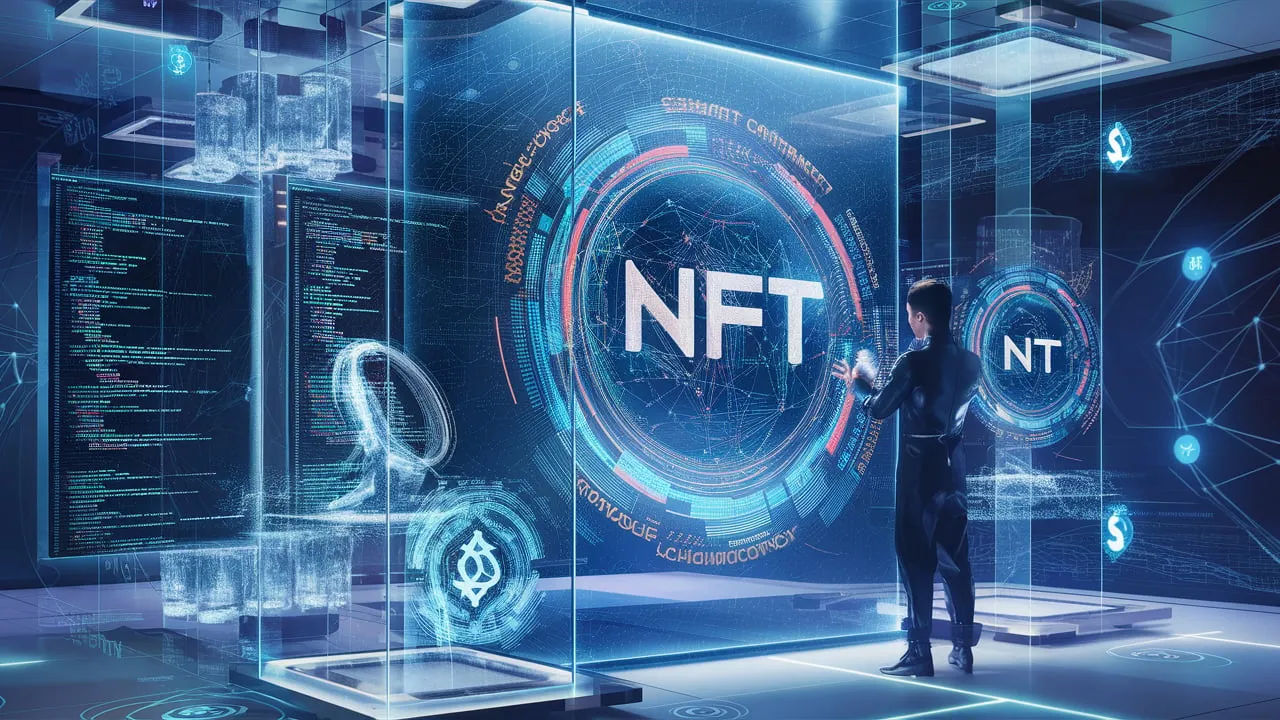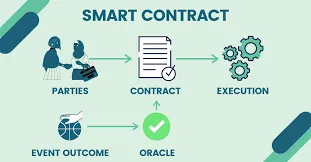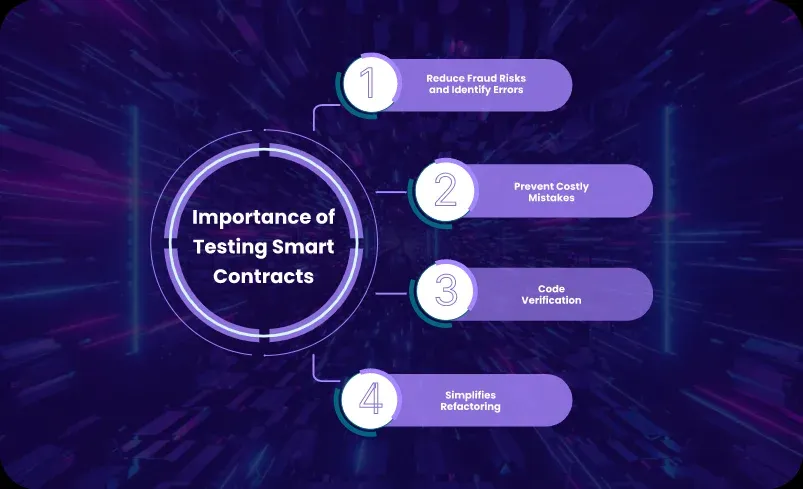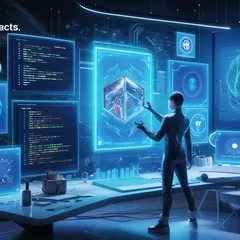
Why do NFT developers perform smart contract testing? They do it because when things as important as NFTs are on the line, security, and performance must be emphasized.
A single error in a blockchain setting might lead to loss of funds or users' funds. Smart contract testing is a complex procedure that demands knowledge and skills.
Smart contracts are great tools for creating NFTs, which are extremely valuable assets. This article digs deeply into the world of NFT smart contract testing, providing you with the right information and tactics you need to protect what you've created.
What is an NFT Smart Contract?

An NFT smart contract is a virtual agreement in which the contract terms involving parties are defined in code. When the specified circumstances are met, the contract automatically executes. Developers build nft smart contracts on decentralized ledger networks.
Smart contract testing is a method of thoroughly analyzing and evaluating a smart contract to test and validate the accuracy of its source code during the development process.
An NFT smart contract oversees the creation, ownership, and movement of these assets across a blockchain network. It functions primarily as a digital ledger, executing established procedures for minting (generating), owning, and trading NFTs.
Solidity: A Programming Language for Building Smart Contracts on Ethereum
Smart contracts are often written in Solidity, a programming language created expressly for writing smart contracts on the Ethereum blockchain. The code defines functions that specify activities such as:
- Minting: This function creates the process of creating new NFTs, which frequently includes a cost or certain requirements.
- Ownership Transfer: This function allows users to transfer ownership of the NFT, ensuring a safe and visible record of who possesses it.
- Metadata Control: This function controls how extra data about the NFT, such as its name or description, is saved and retrieved.
Why You Should Test Your NFT Smart Contract

1) One of the most important reasons for testing NFT smart contracts is to ensure that the code works.
It aids in determining if the code for the NFT smart contract performs as expected and fits the project's standards and requirements.
2) Testing guarantees that the smart contract performs exactly as expected. This ensures that ownership transfers are smooth, minting runs effortlessly, and all other features work as expected.
A well-tested smart contract guarantees a seamless and consistent user experience for all parties involved in the NFT project.
3) The third reason for NFT smart contract testing is to identify and resolve flaws, vulnerabilities, and problems. It can assist in ensuring the safety and efficiency of NFTs.
4) The final objective for testing is to improve the overall performance and quality of the NFT smart contract code.
Smart contract testing before NFT deployment can aid in code optimization for increased scalability and gas consumption.
How to Test NFT Smart Contracts With Tools Like Hardhat, Ganache, and Truffle
Truffle framework, Hardhat, and the Ganache local blockchain can act as modifiers and be used to test smart contracts on NFT.
Truffle framework allows you to write automated tests in JavaScript or Solidity, whereas Ganache replicates Ethereum network circumstances locally by allowing you to deploy and test contracts without spending any real ether or gas.
These tools help to evaluate contract functionality, discover problems, and ensure security before deploying to a live network.
When you are testing NFT smart contracts, prioritize validating important functionalities like
- Constructor and initialization
- Minting and burning
- Transfer and approval operations
- Metadata processing
- Security measures such as access control and permissions.
In simple terms, you want to look for ways that will make your contract fail. Spend as much time as needed attempting to exploit and unlock your contract.
You can also ask questions like:
- Is it possible for users to engage in forbidden actions?
- Can they cause unintended consequences?
- Are payments appropriately processed?
- Can funds be safely transferred across contracts?
- Are fees excessively high owing to resource mismanagement?
You might also want to learn about crypto testnets and mainnets. This article tells you about these systems and their differences
The Different Types of Tests for NFT Smart Contracts
As a blockchain developer, knowing the different types of tests involved with NFT smart contracts is important. In this section, we will look at the 4 different types of testing.
1. Integration Testing
Integration testing is a well-known method for evaluating NFT smart contracts in the practical domain. In this method, smart contracts are tested as a group of their constituent components.
This testing is a good idea for detecting faults that occur during the interaction of distinct elements of a contract between two distinct contracts.
These types of tests are useful for evaluating NFT smart contracts with complex architectures.
2. System Testing
System testing is also a good way to test the general functionality of smart contracts. Furthermore, it is an essential part of the functional testing strategy for smart contracts.
The fundamental goal of system testing is to validate the functionality of smart contracts from the standpoint of users.
3. Unit Testing
It entails individually testing specific smart contract components. The best part about unit testing is how simple the procedures are and how easily faults in the smart contract can be identified.
Unit tests are essential for smart contract development, especially when adding new logic to the smart contract code.
Furthermore, unit testing can assist in ensuring that each function's operating mechanism and desired behavior are met.
Developers can perform unit tests using assertions, which are straightforward statements about what smart contracts are intended to do.
4. Functional Testing
Functional testing aids in comprehending how smart contracts perform in certain scenarios, allowing you to run calculations with specific values and compare the outcomes to your expectations. It also aids in the development of more comprehensive tests.
It is the most common method for automatically testing smart contracts. Functional testing helps you determine if the smart contract meets the requirements you set.
You can also learn how to verify basic NFT smart contracts in this YouTube video. This information is important in building your contract security in crypto and Web3.
How to Write and Run NFT Smart Contract Testing
The following steps will help you to write and run tests in frameworks like Truffle and Ganache.
Step 1: You must first install both on your machine, then use the truffle init command to create a new project directory
Step 2: Write your NFT smart contract in Solidity and store it in the contracts folder of your project directory
Step 3: Write your tests in JavaScript or Solidity and save them in the test folder.
Step 4: You should set up your truffle-config.js file to provide the compiler version, network settings, and deployment options for your smart contract.
Step 5: After running Ganache and generating a new workspace with identical network settings as your truffle-config.js file, you can import some Ganache accounts into your Metamask wallet and connect to your smart contract in the browser.
Step 6: Use the truffle compile command to develop your smart contract and generate JSON artifacts in your project's build folder.
Step 7: Execute the truffle migrate command to set up your smart contract to the Ganache local blockchain. If you make any changes to your smart contract, use the "reset option" to reload it.
Step 8: Use the truffle test command to run your tests and view the results and inputs on the console. You can also use the "show-events" option to examine the events broadcast by your smart contract during the testing.
Conclusion
This article provides you with the framework for testing NFT smart contracts. As you go deeper, look at the resources provided and think about enrolling in online classes or seminars to get hands-on experience.
Developers can use tests to ensure the functionality and security of NFT smart contracts. Furthermore, the tests can assist build documentation that will be useful to new engineers.
By working to secure smart contract development, you will help shape a strong and sustainable future for the NFT ecosystem.
FAQs
Can you create an NFT without a smart contract?
NFTs wouldn't exist without smart contracts, and NFT smart contracts are commonly considered as a single unit that performs the same functions.
These smart contracts can help to manage and develop digital assets. If you want to understand more about non-fungible tokens, start with how they interact with smart contracts.
How can I determine if a smart contract is legitimate?
Enter the address into the block explorer's search bar. Etherscan and other websites will tell you whether the code is confirmed or not, as shown below. You can also see if the contract has a name; if it doesn't, it may be very new or fraudulent.
How do you check an NFT smart contract?
Find the NFT you're looking for on OpenSea. Scroll down and click the drop-down arrow in the 'Details' tab. You may find the 'Contract Address' there. Clicking it will take you to the smart contract on Etherscan.
Why do NFT projects require smart contracts?
Smart contracts are needed for NFT initiatives. To prevent counterfeiting, they first validate the legitimacy of the NFT.
They also enable secure NFT ownership transfers between sellers and buyers. Smart contracts are critical to the NFT ecosystem because their decentralized structure gives transactions credibility and integrity.




